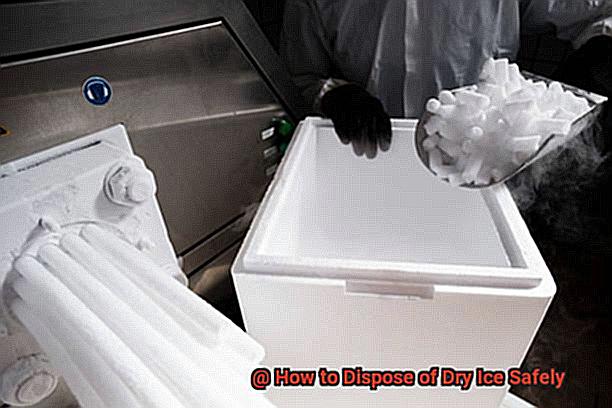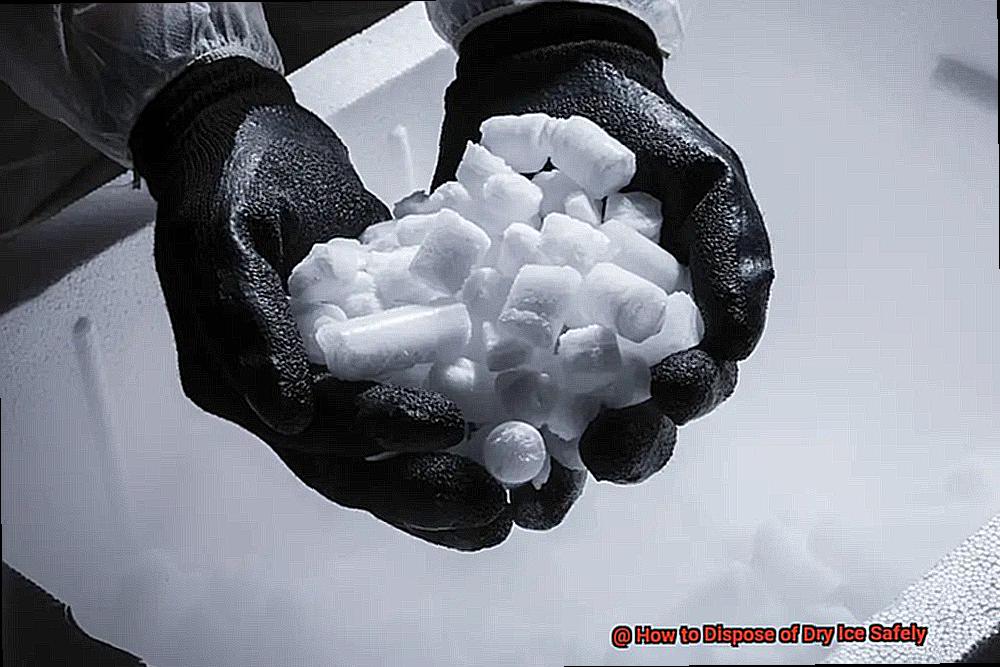Have you ever seen dry ice in action? It can create a mysterious fog and make any event seem like something from a science fiction movie. But when it’s time to clean up, it’s important to know how to dispose of dry ice safely.
Dry ice is frozen carbon dioxide, and if not treated correctly, it can be dangerous. Disposing of dry ice may seem daunting if you don’t know what you’re doing. That’s why we’ve put together this guide on how to properly get rid of it.
We’ll cover everything you need to know about using and disposing of dry ice, including safety tips for handling it, proper disposal techniques, and what to do if you spill some on yourself or someone else. We’ll also address the environmental risks of improper disposal so that you can be confident your dry ice use is as safe and responsible as possible.
So, let’s get started.
Hazards of Improperly Disposing of Dry Ice
Contents
- 1 Hazards of Improperly Disposing of Dry Ice
- 2 How to Dispose of Dry Ice Safely Outdoors
- 3 How to Dispose of Dry Ice Safely Indoors
- 4 How to Dispose of Dry Ice in an Apartment Building
- 5 Do Not Dump Dry Ice into the Sink, Toilet, or Garbage Disposal
- 6 Never Attempt to Break Up Large Chunks of Dry Ice with Tools
- 7 Using Water to Quickly and Safely Dissolve Dry Ice
- 8 Cleaning Up Any Remaining Residue After Melting the Dry Ice
- 9 Conclusion
Dry ice is a frozen form of carbon dioxide that must be handled with great care. If not treated properly, it can lead to serious injuries such as frostbite or burns.
In addition, if left in an enclosed space, dry ice can build up dangerous levels of carbon dioxide, which can cause dizziness, headaches and even death if inhaled. To avoid these risks, it’s important to dispose of dry ice quickly and safely.
When disposing of dry ice, the best option is to allow it to evaporate in a well-ventilated area like outside or in a garage. If you need to discard the dry ice indoors, make sure the area is well ventilated and place the dry ice in a container with a lid.
Never leave dry ice unsupervised or unattended as it can cause severe burns or other injuries if mishandled.
Additionally, never attempt to break up large blocks of dry ice with tools since doing so will create shards that can be dangerous if inhaled or ingested.
If you’re disposing of dry ice in an apartment building, make sure you check with your landlord for any laws or guidelines regarding the safe disposal of this substance.
Moreover, never pour the dry ice into the sink, toilet or garbage can as this could damage plumbing and create hazardous fumes.
How to Dispose of Dry Ice Safely Outdoors
When disposing of dry ice outdoors, safety should be your top priority. The best way to do this is to allow the dry ice to evaporate in a well-ventilated area away from combustible materials, children, and pets. To speed up the process, try spreading the dry ice out in a wide area and looking for a spot with some water nearby.
When handling the dry ice, it is also important to wear protective gear such as gloves and a face mask, as it can cause skin burns if touched directly with bare hands.
Never leave dry ice unattended, nor attempt to dispose of it in a body of water like a lake or river.
How to Evaporate Dry Ice Outdoors
The ideal way to get rid of dry ice outdoors is by allowing it to evaporate naturally in an open space away from buildings, children, and pets.
To hasten the process, spread the dry ice out in a large area and look for an area with some water nearby. Do not attempt to break up large blocks of dry ice with tools as this can result in shards that can be dangerous if inhaled or swallowed.
In addition, make sure you’re wearing protective gear such as gloves and a face mask when handling the dry ice as it can cause skin burns if handled with bare hands.
How to Bury Dry Ice Outdoors
Bury Dry Ice Outdoors is often an effective option for disposing of large amounts of dry ice outdoors safely and efficiently. Always remember to wear protective gear such as gloves and a face mask so you don’t get burned by touching it directly with your hands.
Dig a shallow hole in an open area away from buildings, children, and pets where there is no risk of igniting any combustible material or producing hazardous fumes near any people or animals that may be nearby.
Wrap the dry ice in newspaper before inserting it into the hole so that it melts more quickly while keeping any potential fumes contained until they dissipate properly into the atmosphere.
How to Dispose of Dry Ice Safely Indoors
Dry ice is a frozen form of carbon dioxide that can cause serious injuries if it is not handled correctly. If you need to store dry ice indoors, it’s essential to take the appropriate safety precautions. Here are five tips on how to safely dispose of dry ice indoors.
First and foremost, never store dry ice in a closed container as this will cause pressure to build up and may result in an explosion. Instead, make sure the room is well-ventilated and that the dry ice is stored in an open container with plenty of space for the gas to escape.
Second, when disposing of dry ice indoors, always wear protective gloves as its extreme cold temperature can cause severe burns if handled improperly.
Third, the best way to dispose of dry ice safely indoors is by allowing it to evaporate naturally in a well-ventilated area or by submerging it in a bucket of warm water until all of the CO2 has been released into the air. Never pour any type of liquid onto dry ice as this can create dangerous fumes or explosions.
Fourth, when disposing of dry ice in an apartment building, make sure you check with your landlord regarding any laws or regulations about its disposal.
Finally, never leave dry ice unsupervised as it can cause burns or other injuries if touched directly. Additionally, always have access to water and a sink so that you can safely dispose of the melted water without creating a mess or hazard.
How to Dispose of Dry Ice in an Apartment Building
Living in an apartment building has its perks, but when it comes to disposing of dry ice, extra caution must be taken due to the confined space and shared walls. To make sure everyone stays safe and sound, here are five helpful tips on how to properly dispose of dry ice in an apartment building.
Check with Your Landlord
Before disposing of dry ice in an apartment building, make sure to check with your landlord or building administrator first to ensure that it is allowed.

Use a Ventilated Area
Allowing dry ice to evaporate slowly in a well-ventilated area such as a balcony or outside patio is the safest way to remove it from the premises. If you must dispose of the dry ice indoors, make sure you do so in a room with good ventilation and open windows or doors for proper air flow.
Avoid Airtight Containers
Never use any type of container that can become airtight when sealed as this can cause a dangerous buildup of carbon dioxide.
Keep Away from Combustible Materials
When disposing of dry ice indoors, make sure you do so away from any combustible materials and that the area is clear and free from people and pets.
Wear Protective Gear
Make sure that you have all necessary safety equipment such as gloves and eye protection before handling the dry ice indoors and never leave it unsupervised as it could cause burns or other injuries if touched directly.
By following these simple guidelines for disposing of dry ice in an apartment building, you can protect everyone’s health while also complying with any laws or guidelines set forth by your landlord or building control team.
Do Not Dump Dry Ice into the Sink, Toilet, or Garbage Disposal
When it comes to disposing of dry ice, it’s essential to take extra precautions and make sure that it’s done in a safe and responsible manner. Do not dump dry ice into sinks, toilets, or garbage disposals as this can lead to plumbing issues, blockages, and even explosions due to pressure building up in the pipes.
It’s also important to make sure that all of the dry ice is completely melted before disposing of it. Pieces of dry ice can still cause damage when they come into contact with water. To ensure that no traces of dry ice remain, use protective gear such as gloves when handling the material.
If you need to dispose of large amounts of dry ice, contact a professional who can do so safely and correctly.
Never Attempt to Break Up Large Chunks of Dry Ice with Tools
Breaking up large chunks of dry ice can be a tricky task that requires caution and safety. Never attempt to break up large pieces of dry ice with tools or any other equipment, as this can lead to serious injury or property damage.
Dry ice is extremely cold and can cause frostbite if it comes into contact with your skin, so make sure to wear gloves and protective clothing when handling it.
Additionally, dry ice is incredibly brittle and can easily shatter if not handled correctly.
The safest way to crack up large chunks of dry ice is to let it sublimate naturally or place it in a sealed container and allow the pressure from the release of carbon dioxide gas to break it apart. If you must break up large chunks of dry ice by hand, do so carefully with gloves and other protective gear.
Using Water to Quickly and Safely Dissolve Dry Ice
Dissolving dry ice can be a tricky task, but with the right approach you can do it quickly and safely. Water is the ideal solution for this task, but you must be careful when using it.
Start by adding a small amount of warm or hot water to the container with the dry ice and stirring gently until most of it has dissolved. If necessary, add more warm or hot water in small increments until all of the dry ice is gone. But beware.
Too much water can cause the dry ice to bubble and foam, which can be dangerous. When handling hot water, make sure to take safety precautions – it can cause burns if not handled properly.
Additionally, wear protective gloves when handling dry ice and keep your face away from any fumes that may be released when it dissolves in water.
Cleaning Up Any Remaining Residue After Melting the Dry Ice
Cleaning up after melting dry ice is an important task that shouldn’t be overlooked. Depending on what type of container was used, you may need to use a vacuum cleaner for small particles or a broom and dustpan for larger items.
Make sure to check every corner and crevice for any remaining residue before disposing of it in a safe manner. If there are still some pieces of dry ice that have not melted yet, be sure to place them in a sealed bag or container before discarding.
Taking the right safety precautions when handling dry ice is essential. Wear protective gloves and keep your face away from any fumes that may be released when it dissolves in water. Additionally, if you are using hot water to speed up the process, make sure to take extra care when handling it.
With the right strategy, you can ensure your safety while still disposing of your dry ice properly.
Clean up all remaining residue with a vacuum cleaner or broom and dustpan, then place any unmelted pieces into a sealed bag or container before discarding them in an appropriate manner.
Conclusion
Dry ice can make any event feel like something from a science fiction movie, but it’s important to know how to handle and dispose of it safely.
We’ve covered everything you need to know about using and disposing of dry ice, including safety tips for handling it, proper disposal methods, and what to do in case of spills. We also addressed the environmental risks of improper disposal so you can use this product responsibly.
When disposing of dry ice outside, the best option is to let it evaporate in a well-ventilated area away from combustible materials, children and pets. If indoors, place the dry ice in an open container with plenty of room for the gas to escape. Never attempt to break up large blocks with a knife as that could result in shards of glass that are dangerous if inhaled or swallowed.
Additionally, never pour the dry ice into sinks, toilets or garbage cans as this could damage plumbing and create hazardous fumes.
If living in an apartment building, always consult your landlord first before discarding dry ice as there may be specific laws or regulations regarding its disposal. Furthermore, never leave dry ice unsupervised as this could lead to burns or other injuries.





